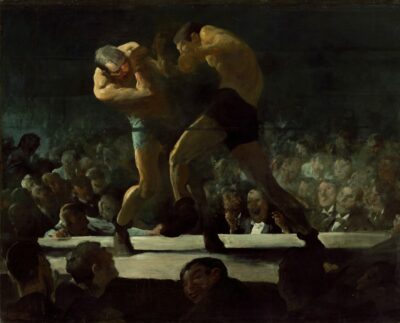Like so many people around the world, I am closely following developments in Ukraine, where it seems that both the Ukrainian Army and civilian volunteers are proving much more of an obstacle for invading Russian forces than Vladimir Putin or his advisors expected. It’s not a fair fight, but the underdog is holding his own right now.

George Bellows, “Club Night” (1907) – Courtesy of the National Gallery of Art
And in the realm of public relations, the underdog is definitely winning. I’ve watched the morale-boosting videos posted by Ukraine’s young comedian-turned-president, Vladimir Zelenskyy, who has defied expectations and advice and remained in the capital city of Kyiv to lead the government in defense of his country. I have watched the videos and interviews of former world heavyweight boxing champion Vitaly Klitschko, the mayor of Kyiv. Along with his brother Vladimir, also a former champion, he is taking up arms to defend his home against this Russian invasion. These videos, especially in the case of the towering Klitschko, a George Bellows painting come to life, feature a three-punch combination of patriotism, courage, and primal masculinity. The right-wing admirers of authoritarianism who have taken Putin as their measure of manliness must be in a bit of a crisis now. Images of the diminutive dictator riding shirtless on a horse are even more “cringe,” as the young people say, than they were before: an embarrassing compensatory cosplay to hide a fundamental cowardice.
The soaring popularity of Ukraine’s president and its most famous mayor, as well as the widespread admiration for the possibly-partly-true-and-surely-partly-legendary “Ghost of Kyiv” ace pilot, are not the only indicators that Ukraine is winning the war for not just the moral high ground but the reputational high ground (they are not always the same).
Here’s another indicator that Ukraine is winning and Russia is not: the discourse on “the West” is shifting once again.
For most of the 20th century after World War II, “the West versus the East” in American parlance meant (roughly) liberal western democracies in western Europe and the United States versus communist totalitarian regimes in eastern Europe and Asia. The NATO alliance was “the West”; the Warsaw Pact countries and China were “the East.” Since the collapse of the Soviet Union and the start of the “War on Terror,” the existential battle understood in “West versus East” framings has been a (sometimes secular) Christianity versus an oppressive Islam. In the 1980s, pundits believed that “Western Civilization” was under threat from Russia and China. In the 2000s and 2010s, Russia became part of “Western Civilization”—part of Christendom—standing against militant Islam.
But in the wake of Russia’s latest military aggression against a former member of the Soviet Union that wants closer ties with the liberal democracies and robust economies of the European Union, mainstream commentators are once again defining “the West” against Russia. This means that Russia is once again excluded from the idea of “Western Civilization.” In the mid-19th century, the easternmost possible imagined boundary of “Western Civilization” would have stretched from the Aegean Sea north through Warsaw to the Baltic. And for most of the 20th century, that same basic geographic division would have applied, though Turkey’s membership in NATO made it what the Crimean War could not: the easternmost outpost of “the West.” Today, though, if you listen to the defense experts, the talking heads, the geopolitical pundits on the major news networks (except Fox News), it seems that the easternmost boundary of “Western Civilization” has shifted. It stretches now from the Sea of Azov north through Melitopol and along the eastern plains of the Dnieper, northwest through Kyiv, then in a broken sweep northward to encompass the Baltic States of Latvia, Lithuania, and Estonia and reach its main northern outpost in Helsinki.
This is not to say that other ideas of “West versus East” have been replaced, never to reappear. The popular framing of Christendom versus Islam still holds sway with many. And the Fox News pundits do seem confused about whether or not Vladimir Putin and Russia are part of “the West” or not.
For now, anyhow, a mid-20th century notion of “Western Civilization,” with an emphasis not on religion or ethnicity but on modern liberal democracy, is once again vying for prominence. It’s a development worth watching.

One Thought on this Post
S-USIH Comment Policy
We ask that those who participate in the discussions generated in the Comments section do so with the same decorum as they would in any other academic setting or context. Since the USIH bloggers write under our real names, we would prefer that our commenters also identify themselves by their real name. As our primary goal is to stimulate and engage in fruitful and productive discussion, ad hominem attacks (personal or professional), unnecessary insults, and/or mean-spiritedness have no place in the USIH Blog’s Comments section. Therefore, we reserve the right to remove any comments that contain any of the above and/or are not intended to further the discussion of the topic of the post. We welcome suggestions for corrections to any of our posts. As the official blog of the Society of US Intellectual History, we hope to foster a diverse community of scholars and readers who engage with one another in discussions of US intellectual history, broadly understood.
We didn’t just invent this notion. It has always been at least partially about democracy going back to Greece vs. Persia. The two world wars certainly had a strong element of liberal democracy vs. authoritarianism. Russia could be part of “the west”. Let us not forget their heroic stands against dictators Napoleon and Hitler. Dictator Putin has plenty of opposition within Russia.